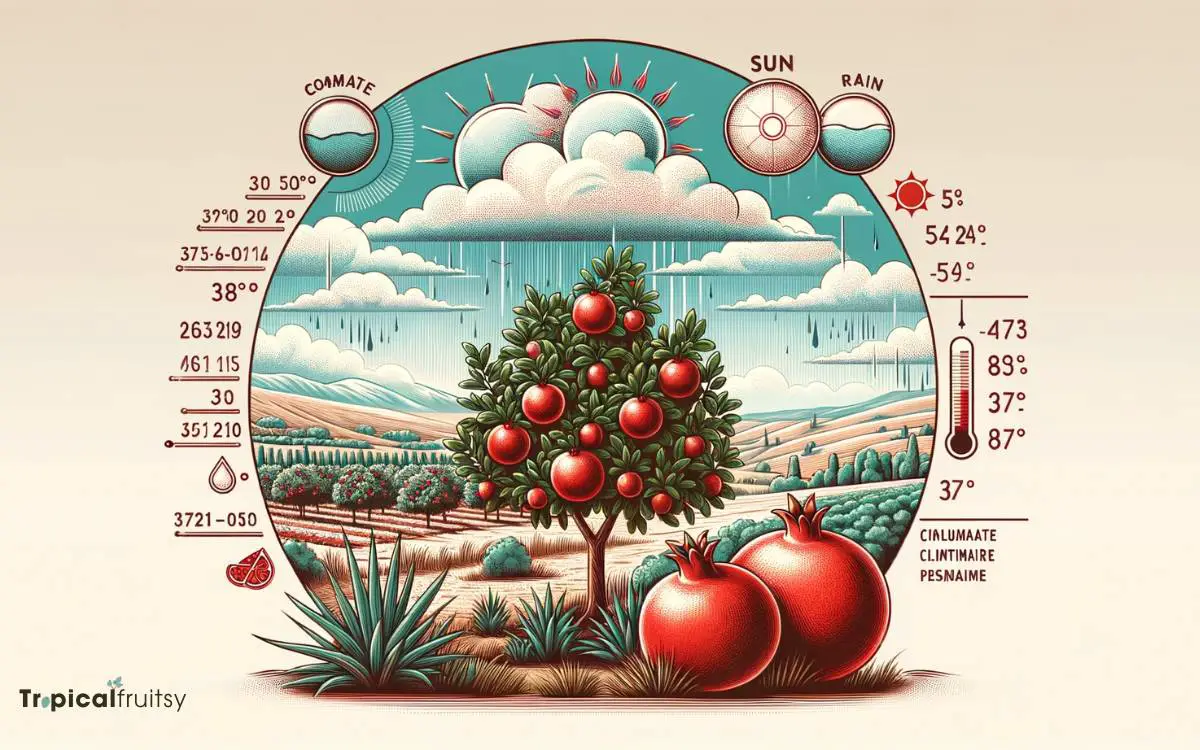Is Pomegranate a Tropical Fruit? No!
Pomegranates are not considered tropical fruits; they are classified as subtropical.
They thrive best in a Mediterranean climate, which is characterized by mild, wet winters and hot, dry summers, rather than the year-round warmth and humidity typical of tropical regions.
Tropical fruits are typically cultivated in regions near the equator that experience consistent, warm temperatures throughout the year and have no frost period. Subtropical fruits, on the other hand, can handle cooler temperatures and even mild frosts.
The pomegranate’s native climate includes cool winters and hot summers, which aligns with subtropical rather than tropical conditions.
Here’s a comparison to illustrate:
Pomegranates prefer temperate climates, offering sweet, jewel-like seeds that burst with flavor and health benefits.

Key Takeaway
Fruit Varieties by Climate Type: Characteristics and Examples
| Climate Type | Characteristics | Example Fruits |
|---|---|---|
| Tropical | Warm year-round, high humidity, minimal temperature variation | Bananas, Mangoes, Papayas |
| Subtropical | Hot summers, mild winters, some frost tolerance | Pomegranates, Oranges, Avocados |
| Temperate | Distinct seasons with cold winters and warm summers | Apples, Pears, Plums |
Defining Tropical Fruit

While the term ‘tropical fruit’ may evoke images of lush, exotic landscapes, scientifically, it refers to fruits that are indigenous to the tropics, a region of the Earth surrounding the equator.
This classification is not merely geographical; it encompasses the biological and ecological characteristics that enable certain fruit species to thrive in the tropics’ distinct climatic conditions.
These conditions include consistent temperatures above 18°C, high humidity, and abundant rainfall.
Tropical fruits are typically adapted to these environments, often exhibiting features such as vibrant colors, distinctive flavors, and rich nutritional profiles.
The classification is critical for agronomists and botanists, who analyze these fruits’ growth patterns, ecological roles, and potential for cultivation in various global contexts.
Pomegranate Origins Explored

The pomegranate, with its origins in the region spanning from Iran to Northern India, is not classified as a tropical fruit but rather as a subtropical species. This distinction is crucial in understanding the fruit’s adaptability and cultivation requirements.
Pomegranates thrive in regions with mild, temperate winters and hot, dry summers, conditions characteristic of a subtropical climate.
These climatic prerequisites align with the fruit’s natural habitat, which extends into the Mediterranean basin.
Historical evidence suggests that pomegranates were cultivated in ancient times, underscoring their long-standing significance to human societies.
The fruit’s proliferation across different cultures and geographies is attributed to its resilience and the ease with which it can be integrated into diverse agrarian systems, further demonstrating its subtropical lineage rather than a tropical one.
Climate Preferences of Pomegranates

In light of their subtropical origins, pomegranates favor climates that offer cool winters and hot, arid summers.
This preference is rooted in their physiological adaptations, which include a dormancy period triggered by cooler temperatures, and a fruiting cycle that benefits from a prolonged period of warmth.
Pomegranates are resilient to temperature variations within their preferred range, but their optimal growth occurs in regions where the average temperature does not dip below freezing.
Furthermore, they thrive in areas with adequate sunshine and low humidity, as excessive moisture can lead to fungal diseases that affect both the tree and the fruit quality.
These climatic predilections underscore the pomegranate’s adaptability to environments that straddle the temperate and tropical zones.
This adaptability raises interesting comparisons between tropical and temperate fruits, which will be discussed in the following section.
Tropical Vs. Temperate Fruits

Understanding the distinctions between tropical and temperate fruits is essential when assessing the classification of the pomegranate.
Tropical fruits are typically grown in regions located between the Tropic of Cancer and the Tropic of Capricorn, where the climate is characterized by consistent warmth and lacks a marked winter season.
These fruits, such as mangoes, bananas, and pineapples, often require high humidity and temperatures to thrive.
In contrast, temperate fruits are adapted to climates with a distinct cold season, which can be crucial for their developmental cycles. Examples include apples, pears, and plums.
Pomegranates, with their ability to withstand cooler temperatures and yet favor hot, arid summers, straddle these definitions.
This duality necessitates a nuanced examination of their optimal growing conditions to ascertain their proper categorization.
What Makes Jackfruit a Tropical Fruit Compared to Pomegranate?
Jackfruit as a tropical fruit is characterized by its large size, spiky green exterior, and sweet, fragrant flavor. Unlike pomegranate, jackfruit thrives in warm, humid climates and is native to South and Southeast Asia. Its tropical origins make it a popular ingredient in many Asian and Caribbean dishes.
Verdict on Pomegranate’s Classification

Pomegranates are not tropical fruits; rather, they are classified as subtropical, thriving best in regions with hot, dry summers and cool, but not freezing, winters.
This categorization aligns with the specific climatic requirements pomegranates demand for optimal growth and fruit development.
To elucidate, pomegranates require a period of chill to become dormant and subsequently produce fruit, a condition not typically found in equatorial, tropical regions.
| Climate Requirement | Pomegranate Adaptation |
|---|---|
| Summer Temperature | Hot and dry |
| Winter Temperature | Cool, frost-free |
| Chill Requirement | Moderate for dormancy |
The table highlights the primary climatic conditions that pomegranates necessitate, which are characteristic of a subtropical climate rather than a tropical one.
This evidence-based classification should guide cultivators and enthusiasts in the accurate botanical placement of the pomegranate.
Conclusion
In the realm of botanical classification, irony abounds as the pomegranate, often associated with the lushness of tropical paradises, is indeed a fruit of temperate lineage.
Despite its vibrant, exotic appeal, this ruby-red treasure thrives under the watchful eye of the four seasons, far removed from the unyielding sun of the tropics.
Thus, in a twist of nature’s own storytelling, the pomegranate eloquently defies the tropical label, flourishing instead within the arms of temperate climes.






